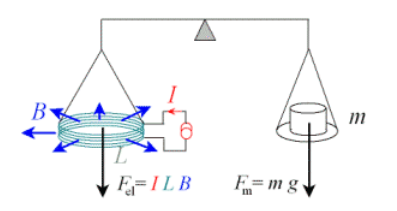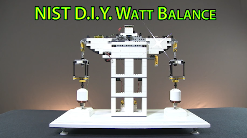Modeling the Kibble Balance
Use what you've learned about the Kibble balance to model its properties.
Teacher Tips!
Many activities have a teacher view and a student view, and teachers can switch between those views by clicking the blue button in the upper-right. Students will not see this option - only teacher accounts see both views. The teacher view will start with overview text, if available, to frame the activity and get you started. This view will also have teacher tips and suggested answers to student questions spread throughout the activity. The teacher text interleaved with student-facing text will be in italics and should appear as a different color on your screen. Teacher tips are designed to help you deliver a learning experience that is best suited for your classroom.
Printing Reminder
Whichever view you see on your screen is what will print. You can print this activity without teacher tips by selecting the student view, or print with teacher tips by switching to teacher view. Simply use the standard print function available for your web browser. No extra steps are required.
Title of Activity: Modeling the Kibble Balance
Brief Description: Using common Lego building blocks and other materials, students look at the engineering practices involved in modeling a Kibble balance. A video leads students through the construction process. The student analysis and discussion can occur with or without actual construction.
Target Grade Level: Grades 8-12
Discipline or Course: Physical Science
Estimated Time Required: 3-5 class periods, with additional time for measurement projects after the balance is calibrated.
Individual / Partner / Group Work: Group
Key Vocabulary:
- Mass
- Planck’s constant
- Watt
- Balance
Teacher Prep:
This open-ended activity does not include a list of materials because developing that list is part of the engineering challenge. The activity is valuable whether or not students proceed to complete the balance project.
Background Knowledge and Extensions:
In the effort to revise and establish a new standard for the measurement of mass, an important technological innovation was the Kibble balance. The instrument was formerly known as the watt balance (renamed in honor of physicist Bryan Kibble, who invented it in 1975).
The Kibble balance compares mechanical power (the force of gravity on a mass) to an equivalent amount of electromagnetic force. Because the precise mass measurements it can make are based on Planck’s constant, the device has the potential of not only increasing accuracy but also making precision (to 3 millionths of a percent) accessible in projects separated by time and space.
Students begin by tracing energy transformations through the balance. Then they examine an engineering project: the construction of a model Kibble balance from Lego bricks.
STUDENT CONTENT BELOW
Making Innovation Possible
The Kibble balance is an important technological innovation that helped standardize the use of Planck’s constant in the measurement of mass. The instrument was formerly known as the watt balance (renamed in honor of physicist Bryan Kibble, who invented it in 1975). Because the precise mass measurements it can make are based on Planck’s constant, the device has the potential of not only increasing accuracy but also making precision (to 3 millionths of a percent) accessible in projects separated by time and space.
Materials:
- Device with internet access
- Web Link - The BIPM Kibble balance (watt balance)
- Web Link - Kilogram: The Kibble Balance
- Web Link - The NIST Do-It-Yourself Kibble Balance (Made with LEGO® Bricks!)
Safety Notes:
There are no anticipated safety risks associated with this activity.
Procedure I: Schematics
The Kibble balance compares mechanical power (the force of gravity on a mass) to an equivalent amount of electromagnetic force. This diagram represents that process.
With the help of resources like Web Link - The BIPM Kibble balance (watt balance) and Web Link - Kilogram: The Kibble Balance define each of the variables in the equations and explain them in words below the diagram.
Using colored pencils or other media, identify the energy flow through the instrument. Remember that while the Kibble is normally used to weigh a mass (m), it can also be used to determine force using a standard mass.
Procedure II: Design Specifications
Watch the video at Web Link - The NIST Do-It-Yourself Kibble Balance (Made with LEGO® Bricks!)
As an engineering team, create a Design Document.
- Write a succinct statement of specifications for the device. Define what it should do.
- List the requirements for a model Lego Kibble balance.
- List all of the materials that would be needed to create the device. You may need to watch the video several times.
- Develop a diagram for the model balance you could build using the directions in the video.
Procedure III: Constraints and Challenges
Imagine that you have built the LEGO Kibble balance as described in the video. List at least 5 scientific questions that you could investigate using the balance.
While answers will vary, students might benefit with some initial ideas. For example, the sensitivity of the balance could record the change in mass as an iron object rusts, the decomposition (release of carbon dioxide) in compost, or verify conservation of mass in a chemical reaction.






